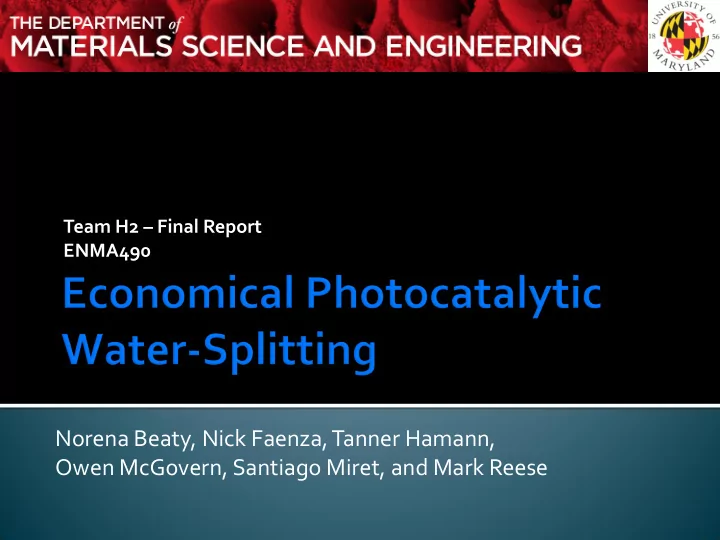

Team H2 – Final Report ENMA490 Norena Beaty, Nick Faenza, Tanner Hamann, Owen McGovern, Santiago Miret, and Mark Reese
Nanoparticle Catalysts Current Energy System Bandgap Engineering Unsustainable Z-scheme system: Fossil fuels vs. hydrogen photocatalyst (oxidation) and co-catalyst (reduction) Source: DOI: 10.1039/B800489G http://www.world-nuclear.org/uploadedImages/org/info/Energy_and_Environment/primaryenergydemand.gif?n=7925
BENEFITS ETHICAL CONCERNS Fabrication Process Potential health dangers of nanoparticles not Non-toxic understood Minimal Waste Risks of water Scalable contamination https://encrypted- http://upload.wikimedia.org/wikipedia/ tbn0.gstatic.com/images?q=tbn:ANd9 commons/thumb/8/8a/Nrborderborder GcS9qwm5TJGYbFMHSwbK_DIYoLuX entrythreecolorsmay05-1-.JPG/300px- 3pRTDSEWc5WrTPV4_5pze5-u Nrborderborderentrythreecolorsmay05 -1-.JPG
Minimization of recombination effects Novel combination of catalyst materials ZnWO 4 and NiO x NiO formation on a ZnWO 4 substrate Kinetic Monte Carlo Simulation Source: DOI: 10.1039/B800489G https://encrypted-tbn1.gstatic.com/images?q=tbn:ANd9GcRn-wG_qYrRtkcFyxisFInmolTUJ8P6V1pNBPfe0hdw8DtqlbdUVQ
DESIGN SIMULATION Design Factors Perform Density Functional Theory • Size • Crystallinity (DFT) Calculations • Surface Area • Determine band edge • Catalyst Material Combination placements • Bandgap Engineering Kinetic Monte Carlo (KMC) Simulations Fabrication and • Improve Fabrication Characterization Conditions
Band edge placements and band gap of materials correlate directly with water-splitting capability of the material Minimum band gap for water- splitting w/o voltage: 1.23 eV CBMin < H 2 O/H 2 level, VBMax > H 2 O/O 2 level Variation as a function of NiO adsorption angle on ZnWO4 A schematic diagram of possible Vienna Ab Initio Simulation band level arrangements for water- Package (VASP) splitting photocatalysts. a) Favorable Ab initio approach is scalable - band level arrangement b) suited to handling large data sets unfavorable VBM position c) unfavorable CBM position. (Wu 2011).
Original plan for surface calculations had to be scaled down to simpler bulk calculations to determine band gap The cells of the materials each had to be relaxed so the minimum energy configuration could be found Lowest energy = most likely configuration
Energy minimization plots for ZnWO 4 (left) and NiO (right). Table I: The calculated and experimental cell parameters for ZnWO4 and NiO. Material c/a (Calculated) c/a (Expt.) a (Calculated) a (Expt.) ZnWO4 1.223379 1.050508 4.744512 4.6925262 NiO 1.05 N/A 2.883756 N/A
ZnWO4 synthesis Sonicate Zn(NO 3 ) 2 and NaWO 4 mixture Filter and wash mixture Calcine for 4 hours at 500 °C Ni Deposition 2 wt% Ni(NO 3 ) 2 is mixed with ZnWO 4 particles in DI water Sonicate to aid mixing The mixture is stirred at 80 °C until dry The powder is calcined at 350 °C for 1 hour
XRD Provided crystal size and composition 89 wt% ZnWO 4 , 11 wt% Na 2 WO 4 ZnWO 4 avg. crystal size = 157 nm SEM Shape, uniformity, and size Spherical and had some agglomeration Particle Size Analysis Determines size distribution Average particle size is around 120 nm ▪ Unsure about size discrepancy Performance Our testing procedure produced inconclusive results Need a gas chromatograph
Model oxidation of nickel nanoparticle Diffusion Chemical reactions Vary parameters Particle diameter Contact angle Oxidation time Nickel nanoparticle (30 degree contact angle) Temperature oxidized for 0.0066 seconds: Use to adjust (0) Vacancy, (1) FCC nickel, (3) adsorbed fabrication process molecular oxygen, (4) atomic oxygen, (5) oxygen bonded to nickel, (6) nickel bonded to oxygen.
Oxidation proceeds faster for smaller contact angle 30 degrees: nearly fully oxidized 60/90 degrees: saturates at low oxidation levels 45 degrees: Fraction of initial nickel atoms that were oxidized. anomalous behavior
Team H2 would like to acknowledge the following faculty and students for their generous support: Prof. Ray Phaneuf (Kinetics, Logistics) Prof. Oded Rabin (Fabrication) Prof. Eric Wachsman (Fabrication) Mr. Colin Gore (Fabrication) Prof. Isabel Lloyd (Characterization) Dr. Kai Zhong (Characterization) Dr. Robert Bonenberger (Characterization) Ms. Jane Cornett (Characterization) Mr. John Abrahams (Characterization) Prof. Ted Einstein (Simulation) Mr. Josue Morales (Simulation) Prof. Yifei Mo (Simulation) This work used the Extreme Science and Engineering Discovery Environment (XSEDE), which is supported by National Science Foundation grant number OCI- 1053575. Maryland Nanocenter. Department of Materials Science and Engineering
Recommend
More recommend